仁爱版七年级上册英语教案:Unit2
- 格式:docx
- 大小:8.87 KB
- 文档页数:2
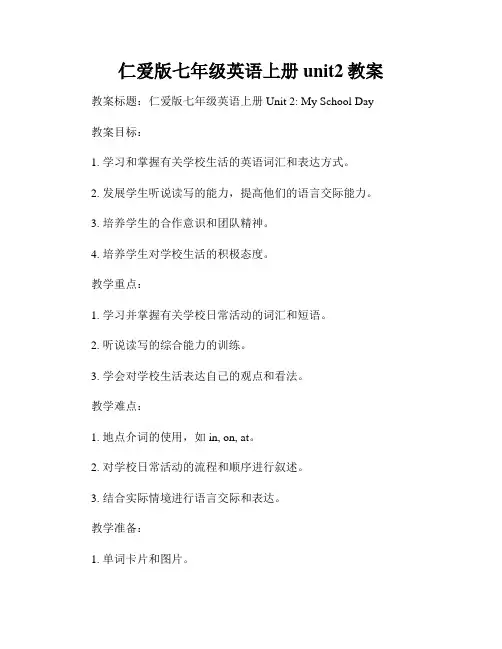
仁爱版七年级英语上册unit2教案教案标题:仁爱版七年级英语上册 Unit 2: My School Day 教案目标:1. 学习和掌握有关学校生活的英语词汇和表达方式。
2. 发展学生听说读写的能力,提高他们的语言交际能力。
3. 培养学生的合作意识和团队精神。
4. 培养学生对学校生活的积极态度。
教学重点:1. 学习并掌握有关学校日常活动的词汇和短语。
2. 听说读写的综合能力的训练。
3. 学会对学校生活表达自己的观点和看法。
教学难点:1. 地点介词的使用,如in, on, at。
2. 对学校日常活动的流程和顺序进行叙述。
3. 结合实际情境进行语言交际和表达。
教学准备:1. 单词卡片和图片。
2. 音频设备和课件。
3. 学生课本和练习册。
4. 计算机和投影仪。
教学过程:一、导入(5分钟)1. 利用图片和图片卡片引入新词汇,让学生猜测并说出新单词的意思。
2. 引导学生回忆并说出他们在学校的日常活动和学习内容。
二、新课呈现(20分钟)1. 呈现新单词和短语,帮助学生正确理解和发音。
2. 聆听录音,跟读新单词和短语。
3. 利用图片和实际情境,帮助学生理解新单词和短语的用法。
三、合作学习(15分钟)1. 将学生分成小组,组织他们进行对话练习,学生可以在对话中运用新学的单词和短语。
2. 学生自由发挥,在小组内表演或描述他们在学校的一天。
四、巩固练习(15分钟)1. 让学生完成课本上的练习,巩固和强化所学的词汇和短语。
2. 利用练习册上的任务,帮助学生进一步训练听说读写的能力。
五、展示与总结(10分钟)1. 随机抽取学生分享他们小组内的对话和表演,鼓励他们展示自己的学习成果。
2. 小结本节课的重点内容,并引导学生思考如何将所学知识运用到实际生活中。
六、作业布置(5分钟)1. 布置练习册上的作业,巩固学习内容。
2. 要求学生记录并描述一天的学校生活,运用所学的词汇和短语。
拓展活动:1. 学生之间进行角色扮演,模拟学校生活中的情境对话。
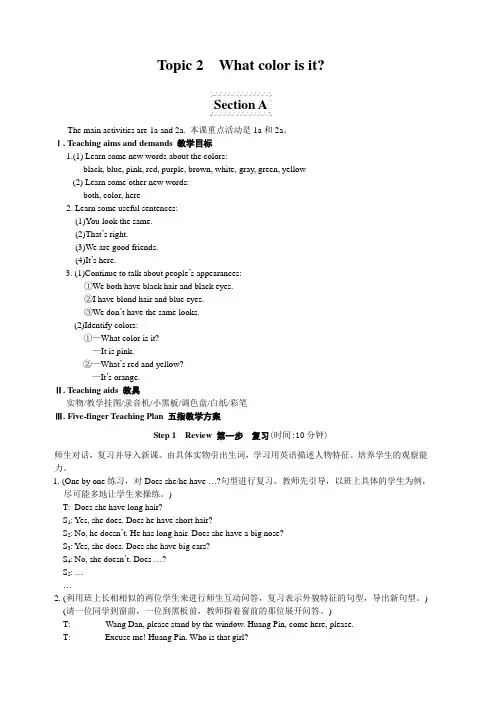
Topic 2 What color is it?Section AThe main activities are 1a and 2a. 本课重点活动是1a和2a。
Ⅰ. Teaching aims and demands 教学目标1.(1) Learn some new words about the colors:black, blue, pink, red, purple, brown, white, gray, green, yellow(2) Learn some other new words:both, color, here2. Learn some useful sentences:(1)You look the same.(2)That’s right.(3)We are good friends.(4)It’s here.3. (1)Continue to talk about people’s appearances:①We both have black hair and black eyes.②I have blond hair and blue eyes.③We don’t have the same looks.(2)Identify colors:①—What color is it?—It is pink.②—What’s red and yellow?—It’s orange.Ⅱ. Teaching aids 教具实物/教学挂图/录音机/小黑板/调色盘/白纸/彩笔Ⅲ. Five-finger Teaching Plan 五指教学方案Step 1 Review 第一步复习(时间:10分钟)师生对话,复习并导入新课。
由具体实物引出生词,学习用英语描述人物特征。
培养学生的观察能力。
1. (One by one练习,对Does she/he have …?句型进行复习。
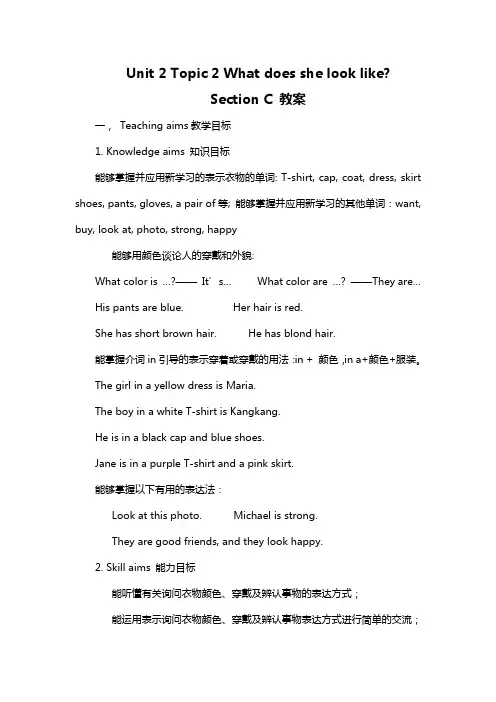
Unit 2 Topic 2 What does she look like?Section C 教案一,Teaching aims教学目标1. Knowledge aims 知识目标能够掌握并应用新学习的表示衣物的单词: T-shirt, cap, coat, dress, skirt shoes, pants, gloves, a pair of等; 能够掌握并应用新学习的其他单词:want, buy, look at, photo, strong, happy能够用颜色谈论人的穿戴和外貌:What color is …?——It’s…What color are …? ——They are…His pants are blue. Her hair is red.She has short brown hair. He has blond hair.能掌握介词in引导的表示穿着或穿戴的用法:in + 颜色,in a+颜色+服装。
The girl in a yellow dress is Maria.The boy in a white T-shirt is Kangkang.He is in a black cap and blue shoes.Jane is in a purple T-shirt and a pink skirt.能够掌握以下有用的表达法:Look at this photo. Michael is strong.They are good friends, and they look happy.2. Skill aims 能力目标能听懂有关询问衣物颜色、穿戴及辨认事物的表达方式;能运用表示询问衣物颜色、穿戴及辨认事物表达方式进行简单的交流;能读懂简短的段落,并能掌握主要信息;能模仿课文,编写询问他人穿戴颜色的对话;能模仿课文,编写他人穿戴的颜色和外貌长相的小短文。
3. Emotional aims 情感目标培养学生善于观察周围人或物的能力。
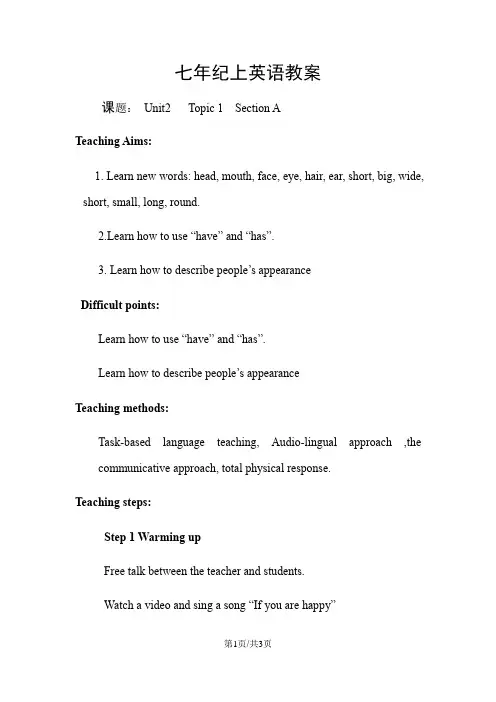
七年纪上英语教案课题:Unit2 Topic 1 Section ATeaching Aims:1. Learn new words: head, mouth, face, eye, hair, ear, short, big, wide, short, small, long, round.2.Learn how to use “have” and “has”.3. Learn how to describe people’s appearanceDifficult points:Learn how to use “have” and “has”.Learn how to describe people’s appearanceTeaching methods:Task-based language teaching, Audio-lingual approach ,the communicative approach, total physical response.Teaching steps:Step 1 Warming upFree talk between the teacher and students.Watch a video and sing a song “If you are happy”Lead-inFrom this video ,we can see many words of body, like hands, feet and eyes. Do you want to learn more about them?Step 2 Presentation1.Learn the new words(1) Learn the new words: listen to 2a carefully and follow ithead, mouth, face, eye, hair, ear, nose, big,wide, short, big, wide, short, small, long, round.Let’s play the game Bobby Says. In order to go over the name of body.(2)Learn the new words: long short, big ,small, wide, round.show pictures and learn adjectives.2 .Remember the new words by themselves. Pay attention to their spellings. Have a competition.Step 3 Consolidation(Ask a student to stand up)T: Who is she?Ss: She is...T: Look, everyone, what does she look like? She has long hair and a round face. What about you? What do you look like?Step 4 listen to the tape 2a and learn how to use have\hasFinish2b and check answersEnjoy an English song “she has, he has”Step 5: Listen and follow 1aListen to the tape and finish 1b.Finish 1c according to 1a and 1b.1. Ask students to follow to read2. Show to read in groups3. Act it out.Step 6: Practice. Ask the students to describe the people in the screen write it down Do reportPlay a guessing game。
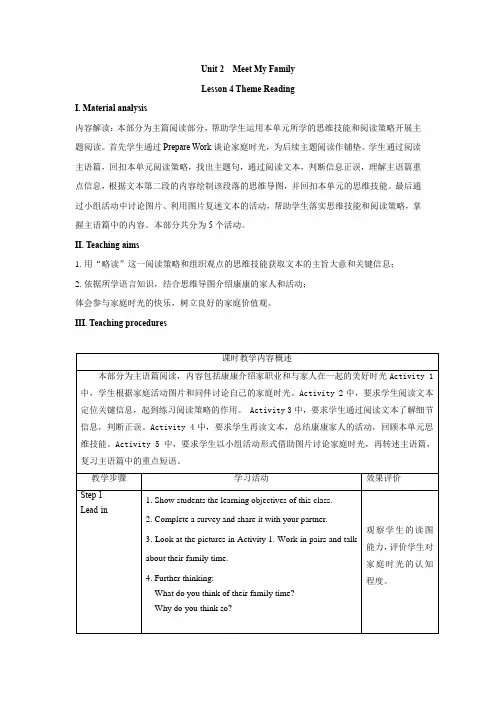
Unit 2 Meet My Family
Lesson 4 Theme Reading
I. Material analysis
内容解读:本部分为主篇阅读部分,帮助学生运用本单元所学的思维技能和阅读策略开展主题阅读。
首先学生通过Prepare Work谈论家庭时光,为后续主题阅读作铺垫。
学生通过阅读主语篇,回扣本单元阅读策略,找出主题句,通过阅读文本,判断信息正误,理解主语篇重点信息,根据文本第二段的内容绘制该段落的思维导图,并回扣本单元的思维技能。
最后通过小组活动中讨论图片、利用图片复述文本的活动,帮助学生落实思维技能和阅读策略,掌握主语篇中的内容。
本部分共分为5个活动。
II. Teaching aims
1.用“略读”这一阅读策略和组织观点的思维技能获取文本的主旨大意和关键信息;
2.依据所学语言知识,结合思维导图介绍康康的家人和活动;
体会参与家庭时光的快乐,树立良好的家庭价值观。
III. Teaching procedures
IV. Blackboard design。

Unit2 Topic1 SectionA 优质课教案I.教学目标1. Learn some new words:(1) Learn words about parts of the body: nose, eye, head, face, hair, ear, mouth, neck.(2) Learn some other new words: guess, have, small, has, big, know, right, round, long, wide, girl, boy, short.2. Learn some useful sentences:(1) Oh, I know.(2) Yes, you’re right.3. Learn the simple present tense with “have/has” and adjectives of description:(1) I have a big nose.(2) They have round faces.(3) She has long hair.(4) It has big ears.4. Learn how to describe people’s appearances.Ⅱ.教具黑板、幻灯片课件Ⅲ.教学过程Step1借助体态语,帮助学生学习语言,并培养他们的观察能力。
1.(教师利用手势唱the Body Song,教师应按照从上到下、从局部到整体的手指人体部位,以便帮助学生记忆。
)Please listen and follow me, I will teach you a body song. Show me your hands and follow me. Please pay more attention to my fingers. I will touch the parts of my body. Let’s go!2.(利用2a的教学幻灯片,操练表示人体部位的名词。
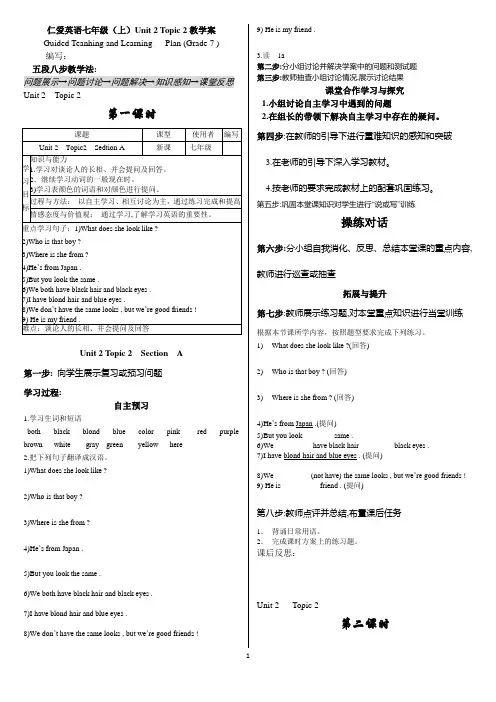
仁爱英语七年级(上)Unit 2 Topic 2教学案Guided Teanhing and Learning Plan (Grade 7 )编写:五段八步教学法:问题展示→问题讨论→问题解决→知识感知→课堂反思Unit 2 Topic 2第一课时Unit 2 Topic 2 Section A第一步:向学生展示复习或预习问题学习过程:自主预习1.学习生词和短语both black blond blue color pink red purple brown white gray green yellow here2.把下列句子翻译成汉语。
1)What does she look like ?_________________________________________________________ 2)Who is that boy ?_________________________________________________________ 3)Where is she from ?_________________________________________________________ 4)He’s from Japan ._________________________________________________________ 5)But you look the same ._________________________________________________________ 6)We both have black hair and black eyes ._________________________________________________________ 7)I have blond hair and blue eyes ._________________________________________________________ 8)We don’t have the same looks , but we’re good friends !_________________________________________________________ 9) He is my friend .________________________________________________________3.读1a第二步:分小组讨论并解决学案中的问题和测试题第三步:教师抽查小组讨论情况,展示讨论结果课堂合作学习与探究1.小组讨论自主学习中遇到的问题2.在组长的带领下解决自主学习中存在的疑问。

Unit2 Looking DifferentTopic 2 what does she look like?Section B:(3-4)教学设计一、Material analysis本节课主要活动是3和4,进一步询问人物外貌特征的表达方法“what does he/she look like?"同时还学习综合颜色、身体部位类单词,以及询问和描述他人外貌特征的表达法,语言板块儿将学习l, w和组合wh的发音规则。
二、Teaching aims1.Knowledge aims能够掌握并应用新学习的单词:letter、sorry、like、look like、tall、will能够用英语询问和描述人物外貌特征的表达方法:she is tall and she has long straight black hair.能够用英语询问人物外貌特征的表达方法:What does the she look like?2.Skill aims能听懂有关询问人物外貌特征的表达方式。
能运用表示询问人物外貌特征的表达方式进行简单的交流。
能根据图片内容口头做对话。
能正确地朗读对话,并能注意语音语调。
能正确书写和使用新学习的单词。
3.Emotional aims能够与同学积极合作参与课堂活动大胆实践。
能够认真、规范地书写单词。
能够培养学生善于观察周围人或物的能力。
三、The key points and difficult pointsKey points1、学会问属于第三人称人物的国籍、外貌、肤色等2、相关形容词的学习:small big long round wide…3,possessive pronounsDifficult points1.have/has在句中的运用及否定表达方式2.物主代词在句中的形式及表达Example: What does the man/woman/boy/girl look like?He/ She is shortHis/her hair is black四、Learning strategies能培养借助图片听说习惯五、Teaching aids教具黑板,图片,多媒体六、Teaching proceduresStep1自主预习一、预习课本P49新单词并识记,完成下面的汉译英。
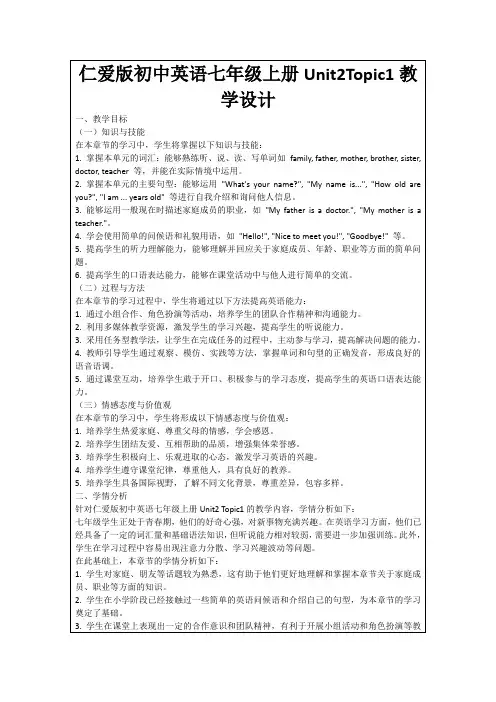
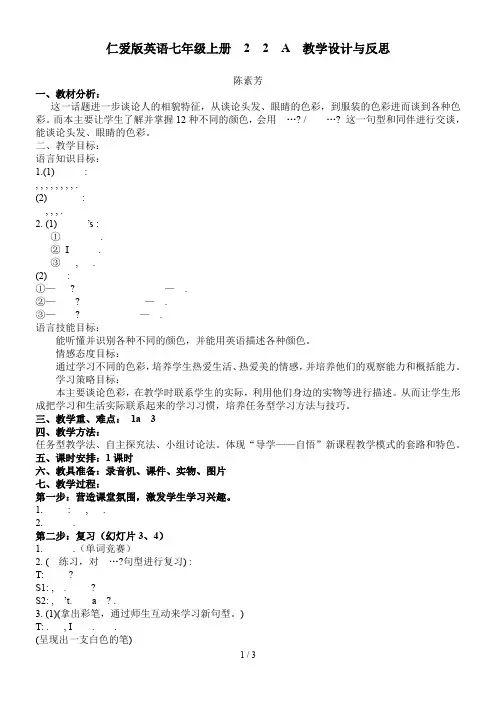
仁爱版英语七年级上册 2 2 A 教学设计与反思陈素芳一、教材分析:这一话题进一步谈论人的相貌特征,从谈论头发、眼睛的色彩,到服装的色彩进而谈到各种色彩。
而本主要让学生了解并掌握12种不同的颜色,会用…? / …? 这一句型和同伴进行交谈,能谈论头发、眼睛的色彩。
二、教学目标:语言知识目标:1.(1) :, , , , , , , , .(2) :, , , .2. (1) ’s :①.②I .③, .(2) :①—? —.②—? —.③—? —.语言技能目标:能听懂并识别各种不同的颜色,并能用英语描述各种颜色。
情感态度目标:通过学习不同的色彩,培养学生热爱生活、热爱美的情感,并培养他们的观察能力和概括能力。
学习策略目标:本主要谈论色彩,在教学时联系学生的实际,利用他们身边的实物等进行描述。
从而让学生形成把学习和生活实际联系起来的学习习惯,培养任务型学习方法与技巧。
三、教学重、难点:1a 3四、教学方法:任务型教学法、自主探究法、小组讨论法。
体现“导学——自悟”新课程教学模式的套路和特色。
五、课时安排:1课时六、教具准备:录音机、课件、实物、图片七、教学过程:第一步:营造课堂氛围,激发学生学习兴趣。
1. : , .2. .第二步:复习(幻灯片3、4)1. .(单词竞赛)2. ( 练习,对…?句型进行复习) :T: ?S1: , . ?S2: , ’t. a ? .3. (1)(拿出彩笔,通过师生互动来学习新句型。
)T: . , I . .(呈现出一支白色的笔)T: ? (学生第一次不懂,马上用汉语解释,学生此时也会用汉语回答:白色。
然后我再用英语重复。
)T: . ’s . (再次对同样的笔重复提问。
)T: ? : ’s .(然后呈现不同颜色的彩笔。
)T: . ? : 红色。
T: . ’s . ? : ’s .(板书新句型和新单词。
领读,并让学生熟读。
)?’s / / / / / / / / / .(2) (句型与单词读完后,把全班分成男女两大组,根据我所指的图片进行问答。

Unit 2 Looking different Topic3 Whose jacket is this第一课时SectionA一.目标语言 Target language(1)重点单词和短语 Words expressionsWhose,his,hers,ours,theirs,yours,mine,then(3)Key sentences—Whose …is it/are these/those…?—It’s (not) mine/hers/yours/these/those are (not)……(3)Teaching important point1 学习物主代词,初步了解名词所有格2 学习谈论物品的所属3 复习名词的复数形式(4)Teaching difficult point1 如何使用名词性物主代词替换掉形容词性物主代词+名词的组合2 then的用法3 如何回答Whose引导的特殊疑问句4 名词单复数形式的变化二.教学呈现Teaching proceduresStep1:Greating(2分钟)Step2:Leading(2分钟)T:I find a pen in my bag. It’s red.It’s not my pen. It’s not mine. Then whose pen is it?—Is it your pen Marssar?—No. It’s not my pen.—Is it yours, Cline?—No. It’s my pen.—Ok.Do you want to find the owner of this pen?—Yes.—Then,let’s study our new topic. “Whose jacket is this?”Step3:Studying the new words(6分钟)1Turn to page 1262Leading the students to read the new words3Pay attention to these words: whose, then, hers, ours, theirs, yours, babyStep4 Preside ting (27分钟)1 拿出属于自己的一件或多件物品,进行师生问答。
Unit2 Topic1 Section A学习目标:1.复习who提问的句型。
2学习单词:head hair eye ear nose mouth face bigwide small long round short3.掌握have/has的用法。
学习重点和难点:1.have/has的用法。
2 .学习新单词。
学习过程:1.自主学习A:Who are you?B:I’m …A:Who is he/she?B:He/She is…2.合作交流,语言点导学(1)I have a small nose,but he has a big one.我长着一个小鼻子,但他长着一个大鼻子。
has是have的第三人称单数,当主语是she,he,it时用has;当主语是I,you,we,they时用have.如:Kangkang has big eyes.I have a small mouth.(2) She has long hair .她留着长发。
long hair 前没不定冠词a,因hair是不可数名词,它没单复数,不用a/an.学习巩固1.单项选择(1)He ____a big head.A.has B.have C.is(2)Mr.Lee has ____short hair, ____small nose and ____wide mouth.A.a;a;aB.a; the; /C./; a; a(3)His____are small, but his nose is big.A.hair B.eyeC.ears(4) ------ Are you Li Ping?------Yes,_________.A.he’sB.you’re rightC.I’m(5)This is my friend.____nose is big. A.He B.His C.She(6)-----Is he Kangkang?------____________.A.Yes, he is.B.Yes, he isn’t.C.No,he is.年级: 七年级科目:英语内容:Topic1SectionB学习目标:1 学习人体各部分名称,能够描述自己的外貌特征;2 熟练使用have/has陈述,疑问和回答。
Writing about looks 教学设计What does he look like?一.教材分析仁爱版七年级上册的核心话题的谈论人物的外表形象。
它衔接了二级目标和四级目标,有承上启下的作用。
二.学情分析从教育学、生理学的角度讲七年级学生好奇心强,有较强的求知欲和模仿能力。
我校学生来自农村,课外学习英语的时间很少。
他们在小学阶段已经学过关于“what does he look like?”的句型,具有了学习本单元知识的前提,能自然的与本单元话题进行衔接。
三.教学目标根据新课标要求和我校学生的实际情况,我将本节课的教学目标设计为:知识目标:掌握描述人物外表的词汇和句型。
能力目标:运用所学过的单词短语句型进行写作输出。
情感目标:激发学生学习兴趣,体会学习英语的乐趣,拓展视野,善于发现美、欣赏美,营造人与社会的和谐美。
四、教学重难点教学重点:熟记描述人物外貌的词汇和句型。
教学难点:如何描述人物的外貌。
五、教法、学法根据以往的教学经验,教学过程中我将采取课前提前预习的方法来弥补学生课外学习英语时间少的不足。
以小组合作讨论的形式提供机会让每个学生开口说英语。
通过任务性教学法,直观演示法有效地突破难点,达到教学效果。
教具:采用了多媒体教学。
Teaching steps:Step1 图片导入学习单词、操练句型。
从头发,身高,体型三方面学习如何表达人物的外貌。
首先观看不同不同发型的明星图片,利用图片直观、形象地学习相关的词汇和句型。
然后要求学生全体起立,现场实体,说并且做:(short medium tall;short medium tall; short short medium medium tall tall ; heavy medium thin ;heavy medium thin ;heavy medium thin ; heavy heavy medium medium thin thin )该活动使学生学以致用,集中了学生的注意力,为接下来pairwork 做好铺垫,用谈论自我作为对话练习,要求学生用第一人称进行表达,让学生更好地了解自己,欣赏自我。
仁爱版七年级上册英语教案:Unit 2
Teaching Plan Background information (背景知识): Students: 52 Middle School students Lesson duration: 45mins
Teaching contents (教学内容): Unit 2 Topic 1 I have a small nose. Section A Teaching aims(教学目标):
1. Learn some new words:
(1)Learn words about parts of the head: nose, eye, head, face, hair, ear, mouth, neck
(2)Learn some other new words: guess, know, wide, right, girl, boy, have, has, small, big, round, short, long,
2. Learn some useful sentences:
⑴ I/You/We/They have …
(2)She/He/It has …
(3)---Do you have … ?
---Yes, I/We do. No, I/We don 't.
(4)--- I know.
--- You ' re right.
3. Learn how to describe people 's appearances.
Teaching focus(重点): words about parts of the head and adjectives of description
Teaching difficulties(难点): The usages of have and has Teaching procedures:(教学步骤) Step1 Warm-up 第一步热身
greeting sing a song : Head and shoulders.
Step2 Review 第二步复习
(1)通过复习,培养学生根据卡片信息进行简单交流的能力。
(出示卡片上文字信息,师生进行互动问答。
复习描述人的基本情况。
) Name: Jane
Age: 11 From: Canada School: Beijing International School Class: Nine Grade: Seven
Phone number: (010)9267-6929
(1)T: What 's her name? S1: Her name is Jane.
T: How old is she?S2: She is eleven.
T: Where is she from?S3: She is from Canada.
(2)(根据图画导入新内容。
)
Step 3 Presentation 第三步呈现利用简笔画教授人体部位的名称,并在图片的相应位置板书单词,然后领学生拼读。
(2)(利用卡片,操练表示人体部位的名词。
) T: Let ' s look at this picture.
What 's this? S1, please.S1:Eyes.
T:How do you spell it, please?S1:E-Y-E-S,eyes.
(以同样方式操练其他表示人体部位的名词。
)
T: Nice work, boys and girls. (教学boy and girl)
(3)通过对比图片学习描写人体头部的形容词(long hair, big eyes, small eyes,
a round face …)
⑷(出示2a的教学挂图,让学生观察图片中突出的外貌特征,巩固表示人体部位的名词和部分形容词。
)
T: OK, now look at these pictures. Let 's talk about their different
looks. Is this a big nose?
Ss:Yes. It 's big.
T: Good. He has a big nose. Are they big, too?Ss:No. T: Very good. They are not big. They are small. They have small noses and small eyes.
(以同样方式操练其他四幅图片。
)
(5)(在熟练掌握人体部位和描述人体部位形容词的基础上,结合2a的教学图片,让学生操练形容词+人体部位的短语,然后教授have和has的用法,进而过渡到完整的句子。
)
① have: S(I/We/You/They) +have …
② has: S(He/ She/ It)+has …
Step 4 Consolidation 第四步巩固
1.(小组竞赛。
限定时间要求学生书面完成2b。
核对答案,并让学生复述
have/has 的用法,最后让学生齐读这七个句子。
)
2. (接龙游戏。
教师根据自己的实际情况以第一人称说一个句子,学生模仿练习。
)
S1:I have a small nose.
S2: I have a long face.
S3: I have a big head.
S4: …
Step 5 Practice 第五步练习
完成1a,1b进一步帮助学生巩固本课的功能项目,培养学生的听说能力。
Sing a song
Step 6 Summary 第六步总结
Summarize the new words.
Summarize the grammar.
Summarize the useful expression
Step 7 Homework 第七步作业(1) 预
习Section B 的生词
(2) 描述一位朋友的外貌。